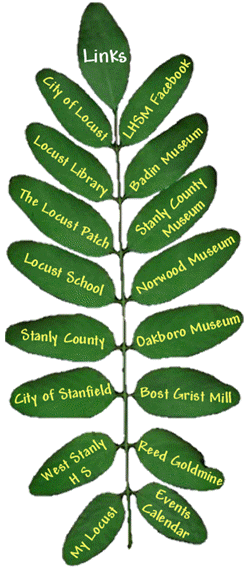The Locust Historical Society & Museum welcomes you to our home on the web.
Introduction
The Locust Historical Society and Museum was formed to preserve, organize and display items of historical interest to Locust and the surrounding area. Local family histories, written and oral, are welcome, as are photographs, documents and artifacts. After visiting the Oakboro Museum in 2006 Gary Tucker (a lifetime resident) began to think about a way to preserve the history of Locust. Soon thereafter, Gary noticed an ad in the “Weekly Post” by Pat Long asking for a meeting with anyone with similar interests. Indeed there was an interest in forming an organization dedicated to the preservation of Locust’s history. With the help of City officials and the original members, Locust Historical Society & Museum, Inc. was formed in June of 2007. A 501C-3 non-profit status was obtained shortly after. The first artifacts were displayed in December of 2007. A portion of the City Council meeting room was graciously made accessible to the organization. Currently the museum is in the process of moving to it's new location.
As they say in the movies “The rest is history”.
History
The City of Locust was established in western Stanly County in the late 1860s by German, Scotch Irish and English immigrants. The community was known as the "Crossroads". Many travelers came through on the way to Cabarrus, Anson, and Mecklenburg counties.
A central well was dug close to the locust tree to serve the citizens of the community as well as travelers and their livestock as they were traveling through. As many as 25 families would do their washing there in a single day, since it was the only source of water. In 1869 population in the "Crossroads" community had increased enough to warrant an application for the establishment of a post office. There was a meeting held to decide on a new name and a young girl in the community, Miss Maggie Howell, was present at a meeting to decide a proper name. Maggie happened to look out at a wooded plot where a large locust tree was in full bloom. Beyond the locust tree, plowed fields laid flat and the reddish clay dirt of the Charlotte Road stretched out level. Miss Howell suggested the name "Locust Level". And so it was called until May 29, 1894. The Level was dropped and it was simply called Locust. Locust still serves as the crossroads to Charlotte, Albemarle, Concord and Monroe. It is a thriving community and represents opportunity for growth and expansion of businesses. (More Complete History) |
 More Links |